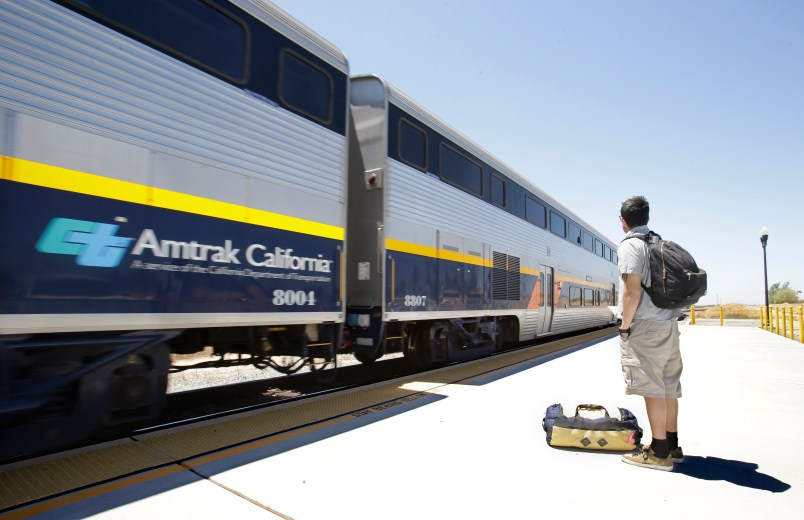SACRAMENTO, Calif. (AP) — A judge on Monday tore up California’s funding plans for what would be the nation’s first bullet train, issuing separate orders that could force the state to spend months or years redrawing its plans for the $68 billion rail line and could choke off some of its funding.
Sacramento County Superior Court Judge Michael Kenny rejected a request from the California High-Speed Rail Authority to sell $8 billion of the $10 billion in bonds approved by voters in 2008, saying there was no evidence it was “necessary and desirable” to start selling the bonds when a committee of state officials met last March.
He said the committee, which included state Treasurer Bill Lockyer, was supposed to act as “the ultimate ‘keeper of the checkbook'” for taxpayers, but instead relied on a request from the high-speed rail authority to start selling bonds as sufficient evidence to proceed.
In a separate lawsuit, Kenny ordered the rail authority to redo its $68 billion funding plan, a process that could take months or years, although rail authority officials say they have already started and believe it can be done much more quickly than that. He had previously ruled that the authority abused its discretion by approving a funding plan that did not comply with the law. The judge said the state failed to identify “sources of funds that were more than merely theoretically possible.”
It is also unclear who will decide if the new funding plan is sufficient. It will be submitted to the board that oversees the rail line, whose members have been appointed by Gov. Jerry Brown, a project booster, and the Democrat-controlled Legislature.
Proposition 1A, which voters approved in 2008, required the rail authority to specify the source of the funding for the first operable segment of the high-speed rail line and have all the necessary environmental clearances in place. Kenny had said the agency did not comply with either mandate in approving the start of construction from Madera to Fresno, about 30 miles.
The plaintiffs, a group of Central Valley residents and farmers, believe the requirement applies to the first 300 miles stretching as far as Bakersfield with a projected price tag of $31 billion. But the rail authority contends it applies only to the first “useable” segment of track in the Central Valley.
“The court said, look, you’ve only got 28 miles with completed environmental clearances. I order that you have to have 300 miles of environmental clearances,” said Michael Brady, an attorney for residents who had sued to halt the project. “It’s taken them five years to do 28 miles, so how long will it take them to do 300 miles?”
Still, Kenny stopped short of blocking the project altogether, and rail authority officials characterized Monday’s rulings as a setback rather than a fatal blow.
“Like all transformative projects, we understand that there will be many challenges that will be addressed as we go forward in building the nation’s first high-speed rail system,” rail authority Chairman Dan Richard said in a written statement.
The authority’s CEO, Jeff Morales, disagreed with claims by the opponents that the judge’s rulings would send high-speed rail planners back to the drawing board, saying officials are confident they can address the judge’s concerns quickly. When asked how much time it could take, he said, “Not long. We don’t think that addressing that will have any material effect on the project.”
The rail authority had argued that it has already updated its funding plan and that it intends to spend $3.2 billion in federal money before tapping the state bonds. It also argued that only the Legislature could intervene to stop the project.
The plaintiffs had also asked Kenny to block spending of the federal funds and rescind construction contracts, including a $1 billion deal signed this fall, but the judge declined to do so Monday, saying there was no evidence “that there has been any impropriety” in spending.
He also did not invalidate the bonds, merely saying that officials would need to present more evidence about why they need to be sold and when before the committee should approve the sales. But without authorization to sell bonds, the bullet train’s financing sources could dry up.
California has already issued more than $705 million in Proposition 1A bonds, about $400 million for high-speed rail and about $305 million for related rail-improvement projects that could eventually be connected.
The plans have changed significantly since voters approved the train, along with the costs — from $45 billion in 2008 to more than $100 billion in 2011 and, now, $68 billion for a 520-mile line connecting San Francisco and greater Los Angeles through the Central Valley.
Political considerations and opposition by local residents statewide have also forced repeated changes. Jon Coupal, executive director of the Howard Jarvis Taxpayers Association, which had sued over the bonds, blamed the ever-changing plans for the judge’s decisions Monday.
“The project now is so divergent from what the voters were told that I don’t think he had any other choice,” Coupal said.
Copyright 2013 The Associated Press. All rights reserved. This material may not be published, broadcast, rewritten or redistributed.






